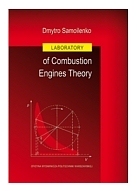Laboratory of Combustion Engines Theory
The present work will be devoted to the study of how the technical problems related to
the design of combustion engines could be solved based on the fundamental laws of
thermodynamics. Practical examples of how to use thermodynamics for describing physical
phenomena and mathematical simulations of heat exchange processes in the combustion
engines will be presented. All the well-known solutions used in the vehicles engineering
and related to the fundamental theory of combustion engines are presented in the current
work. These solutions are piston compressors (used as an auxiliary equipment or external
compressors in turbocharger assistance system), automobile air conditioning systems and
internal combustion engines.
Special attention will be paid to the theory, fundamental processes analysis (based on
empirical tests results) and in the case of internal combustion engines – to the
influence of harmful substances contained in the exhaust gas on the environment.
Preface. 5
1. Piston compressor 7
1.1. Introduction 7
1.2. Compressors types. 7
1.3. Design solutions. 8
1.4. Operating principle of piston type compressor 9
1.5. Theoretical backgrounds 10
1.5.1. The theoretical compressor without harmful volume 10
1.5.2. The theoretical compressor with harmful volume. 11
1.5.3. Comparison of the theoretical compressor without harmful volume and the theoretical
compressor with harmful volume 13
1.5.4. Boundary compression ratio 13
1.6. Comparison of the compressors working cycles. 14
1.7. Handling compressor indicator diagram 15
1.8. Calculation of the theoretical compressor without harmful volume 19
1.9. Calculation of the theoretical compressor with harmful volume. 20
1.10. Values for the comparison 21
1.11. The purpose of the laboratory work. 21
1.12. An experimental unit 22
1.13. Necessary data for the preparing the laboratory work report 23
1.14. Summarizing calculations results 24
1.15. Report of the laboratory work 24
2. Car air conditioner system . 25
2.1. Introduction 25
2.2. The theory – car conditioning principle. 25
2.3. Theory of refrigerants 27
2.4. Air conditioning system of the car. 29
2.5. A/C System major components 30
2.6. The laboratory test setup 37
2.7. Laboratory exercise 39
3. Indicat or diagram . 43
3.1. Introduction 43
3.2. Calculations of engine operating parameters based on the indicator diagram. 45
3.3. The efficiency and energy balance of the combustion engine. 48
3.4. Theoretical cycles of four-stroke combustion engines 51
3.5. Matching the theoretical cycle to the actual closed indicator diagram of the engine
57
3.6. The aim of the laboratory exercise. 59
3.7. Tasks. 59
3.8. Laboratory report. 60
4. Characteristics of internal combustion engine . 61
4.1. Speed characteristics of the internal combustion engine. 61
4.1.1. The definition of spark ignition engine speed characteristic 61
4.1.2. Engine test bench and examination procedure. 64
4.1.3. The main equations used for engine operation parameters calculations 66
4.1.4. Laboratory report content 68
4.2. Load characteristic of the internal combustion engine 69
4.2.1. Parameters of the load characteristic. 69
4.2.2. Main formulas used in the measurement results processing 73
4.2.3. A consequence of the exercise implementation. 73
4.2.4. The content of the report 75
5. MEASUREMENTS OF POLLUTANT EMISSIONS FROM COMBUSTION ENGINES 76
5.1. Harmful substances formation in the exhaust gas of internal combustion engines. 76
5.2. Effect of exhaust gases harmful substances emission on the environment. 79
5.3. Hazards caused by toxic compounds emitted by combustion engines – selected toxic
components in exhaust gases. 80
5.4. Methods used for measurement of the concentration of toxic constituents in the
exhaust gas 85
5.5. Methods used for measurement of solid particles 87
5.6. Study on specific emission of exhaust gas toxic components 89
5.6.1. Emission norms for toxic substances obligated for non-road vehicles 89
5.6.2. Processing of the measurement results 92
Refernces 93
94 pages, Paperback


